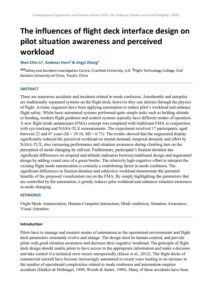| Document | Author Wen-Chin Li, Andreas Horn & Jingyi Zhang |
| Abstract There are numerous accidents and incidents related to mode confusion. Autothrottle and autopilot are traditionally separated systems on the flight deck, however they can interact through the physics of flight. Avionic engineers have been applying automation to reduce pilot’s workload and enhance flight safety. While basic automated systems performed quite simple tasks such as holding altitude or heading, modern flight guidance and control systems typically have different modes of operation. A new flight mode annunciator (FMA) concept was compared with traditional FMA in conjunction with eye-tracking and NASA-TLX measurements. The experiment involved 17 participants, aged between 22 and 47 years (M = 29.18, SD = 6.73). The results showed that the augmented display significantly reduced the perceived workload on mental demand, temporal demand, and effort by NASA-TLX; also increasing performance and situation awareness during climbing turn on the perception of mode changing by call-out. Furthermore, participant’s fixation duration has significant differences on airspeed and altitude indicators between traditional design and augmented design by adding visual cues of a green border. The relatively high cognitive effort to interpret the existing flight mode annunciation is certainly a contributing factor in mode confusion. The significant differences in fixation duration and subjective workload demonstrate the potential benefits of the proposed visualization cue on the FMA. By simply highlighting the parameters that are controlled by the automation, it greatly reduces pilot workload and enhances situation awareness in mode changing. |

